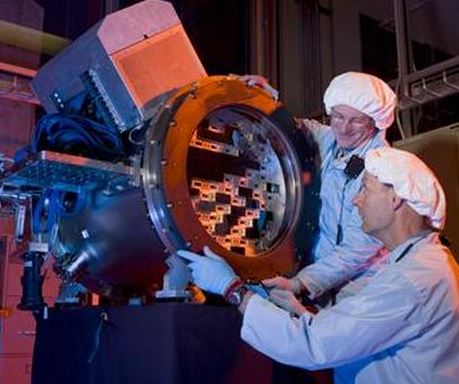Nobody fully understands what the role of dark matter in the universe is. Scientists have created the first in a series of dark matter maps of the universe which they say will help them better understand their role in how galaxies form and why the universe behaves as it does.
The maps were created with data gathered from the Dark Energy Camera, a 570-megapixel imaging device – the Dark Energy Survey’s main instrument.
Dark matter is material we know exists in the universe, even though we cannot detect it by its emitted radiation. We know it exists because of its gravitational effects on things we can see, like stars and galaxies. According to scientists, dark matter makes up one quarter of the universe.
 This Dark Energy Survey map traces the detailed distribution of dark matter across a large part of the sky. Red and yellow represent regions with more dense matter. (Credit: Fermilab)
This Dark Energy Survey map traces the detailed distribution of dark matter across a large part of the sky. Red and yellow represent regions with more dense matter. (Credit: Fermilab)
Dark matter’s effects can be observed by studying gravitational lensing – the distortion that occurs when its gravitational pull bends light around far away galaxies.
Maps will provide insight into dark energy
Dark Energy Survey researchers, who created these dark matter maps, explained that by analyzing the clumpiness of dark matter in their maps, they will also gain insight into the nature of the enigmatic dark energy, which they believe causes the accelerating expansion of the universe.
The scientists released the new maps at the meeting of the American Physical Society in Baltimore, Maryland.
They plan to understand the role of dark matter so that they can quantify dark energy’s role, which is their ultimate goal.
Dark matter vs. dark energy
Dark energy repels while dark matter attracts. Dark energy pushes matter outward while dark matter pulls it inward.
While dark energy shows itself only on the biggest cosmic scale, dark matter wields its force on individual galaxies as well as the universe generally.
The analysis was led by Chihway Chang, of ETH (Eidgenössische Technische Hochschule- Swiss Federal Institute of Technology) Zurich, and Vinu Vikram, of Argonne National Laboratory (then at the University of Pennsylvania).

Scientists building the Dark Energy Camera. (Image: Dark Energy Survey)
Dr. Chang, Dr. Vikram, and colleagues at the Universities of Manchester and Portsmouth in England, ETH Zurich, the University of Pennsylvania in the US, and other DES institutions collaborated for more than a year to carefully validate the lensing maps.
Dr. Vikram said:
“We measured the barely perceptible distortions in the shapes of about 2 million galaxies to construct these new maps.”
“They are a testament not only to the sensitivity of the Dark Energy Camera, but also to the rigorous work by our lensing team to understand its sensitivity so well that we can get exacting results from it.”
The camera, which is mounted on the 4-meter M. Blanco telescope at the National Optical Astronomy Observatory’s Cerro Tololo Inter-American Observatory in Chile, was built and tested at the Fermi National Accelerator Laboratory (Fermilab). Its data were processed at the University of Illinois in Urbana-Champaign’s National Center for Supercomputing Applications.
The dark matter maps released earlier this week cover just 3% of the area of sky that the DES is expected to document when its 5-year mission is completed.
Comparing dark matter with visible matter
The survey has just completed two of its planned five years. As their search expands, scientists hope to better test current theories regarding the cosmos by comparing the quantities of dark matter with visible matter.
The theories suggest that our universe has much more dark matter than visible matter, and galaxies form where large concentrations of dark matter, and consequently stronger gravity, are present.
Researchers will learn more about this interplay of light and mass in follow-up studies of some of the massive filaments and voids.
Dr. Chang said:
“Our analysis so far is in line with what the current picture of the universe predicts. Zooming into the maps, we have measured how dark matter envelops galaxies of different types and how together they evolve over cosmic time. We are eager to use the new data coming in to make much stricter tests of theoretical models.”
The Dark Energy Survey involves more than 300 scientists from 25 institutions in six countries.
Video – Mapping dark matter
